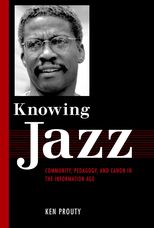Knowing Jazz: Community, Pedagogy, and Canon in the Information Age
Knowing Jazz: Community, Pedagogy, and Canon in the Information Age
Cite
Abstract
This book argues that knowledge of jazz, or more to the point, claims to knowledge of jazz, are the prime movers in forming jazz’s identity, its canon, and its community. Every jazz artist, critic, or fan understands jazz differently, based on each individual’s unique experiences and insights. Through playing, listening, reading, and talking about jazz, both as a form of musical expression and as a marker of identity, each aficionado develops a personalized relationship to the larger jazz world. Through the increasingly important role of media, listeners also engage in the formation of different communities that not only transcend traditional boundaries of geography, but increasingly exist only in the virtual world. The relationships of “jazz people” within and between these communities is at the center of this book. Some groups, such as those in academia, reflect a clash of sensibilities between historical traditions. Others, particularly online communities, represent new and exciting avenues for everyday fans, whose involvement in jazz has often been ignored. Other communities seek to define themselves as expressions of national or global sensibility, pointing to the ever-changing nature of jazz’s identity as an American art form in an international setting. What all these communities share, however, is an intimate, visceral link to the music and the artists who make it, brought to life through the medium of recording. Informed by an interdisciplinary approach and approaching the topic from a number of perspectives, the book charts a philosophical course in which many disparate perspectives can find common ground.
-
Front Matter
- Introduction: Studying Jazz Studies: Toward an Epistemology of Jazz, or: How I Learned to Stop Worrying and Love the Canon (or at least live with it…)
-
1
The Problem with Community
-
2
Jazz Education and the Tightrope of Tradition1
-
3
Doing and Teaching (and Researching)
-
4
The Virtual Jazz World
-
5
The Global Jazz Community
-
End Matter
Sign in
Personal account
- Sign in with email/username & password
- Get email alerts
- Save searches
- Purchase content
- Activate your purchase/trial code
Institutional access
-
Sign in through your institution
- Sign in with a library card Sign in with username/password Recommend to your librarian
Institutional account management
Sign in as administratorPurchase
Our books are available by subscription or purchase to libraries and institutions.
Purchasing information| Month: | Total Views: |
|---|---|
| October 2022 | 1 |
| November 2022 | 2 |
| February 2023 | 2 |
| February 2023 | 1 |
| March 2023 | 2 |
| March 2023 | 2 |
| March 2023 | 2 |
| March 2023 | 3 |
| March 2023 | 2 |
| March 2023 | 2 |
| March 2023 | 1 |
| March 2023 | 2 |
| March 2023 | 2 |
| April 2023 | 4 |
| April 2023 | 2 |
| April 2023 | 2 |
| April 2023 | 1 |
| April 2023 | 2 |
| April 2023 | 2 |
| April 2023 | 12 |
| April 2023 | 5 |
| October 2023 | 2 |
| October 2023 | 1 |
| October 2023 | 2 |
| January 2024 | 1 |
| January 2024 | 3 |
| January 2024 | 2 |
| February 2024 | 1 |
| February 2024 | 1 |
| February 2024 | 3 |
| April 2024 | 2 |



Get help with access
Institutional access
Access to content on Oxford Academic is often provided through institutional subscriptions and purchases. If you are a member of an institution with an active account, you may be able to access content in one of the following ways:
IP based access
Typically, access is provided across an institutional network to a range of IP addresses. This authentication occurs automatically, and it is not possible to sign out of an IP authenticated account.
Sign in through your institution
Choose this option to get remote access when outside your institution. Shibboleth/Open Athens technology is used to provide single sign-on between your institution’s website and Oxford Academic.
If your institution is not listed or you cannot sign in to your institution’s website, please contact your librarian or administrator.
Sign in with a library card
Enter your library card number to sign in. If you cannot sign in, please contact your librarian.
Society Members
Society member access to a journal is achieved in one of the following ways:
Sign in through society site
Many societies offer single sign-on between the society website and Oxford Academic. If you see ‘Sign in through society site’ in the sign in pane within a journal:
If you do not have a society account or have forgotten your username or password, please contact your society.
Sign in using a personal account
Some societies use Oxford Academic personal accounts to provide access to their members. See below.
Personal account
A personal account can be used to get email alerts, save searches, purchase content, and activate subscriptions.
Some societies use Oxford Academic personal accounts to provide access to their members.
Viewing your signed in accounts
Click the account icon in the top right to:
Signed in but can't access content
Oxford Academic is home to a wide variety of products. The institutional subscription may not cover the content that you are trying to access. If you believe you should have access to that content, please contact your librarian.
Institutional account management
For librarians and administrators, your personal account also provides access to institutional account management. Here you will find options to view and activate subscriptions, manage institutional settings and access options, access usage statistics, and more.